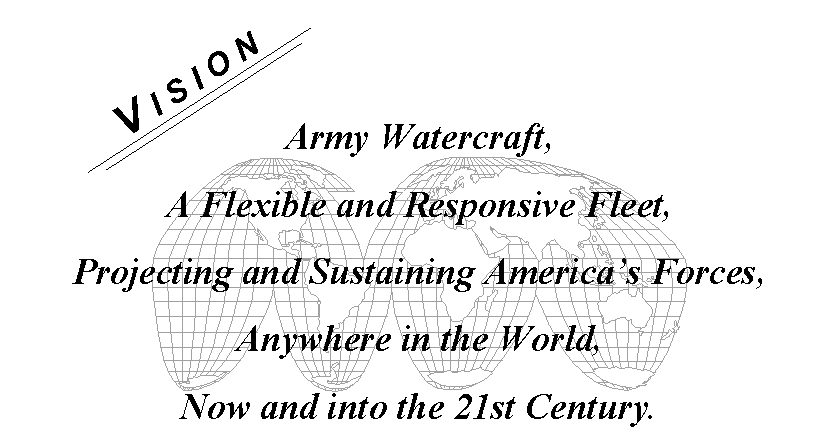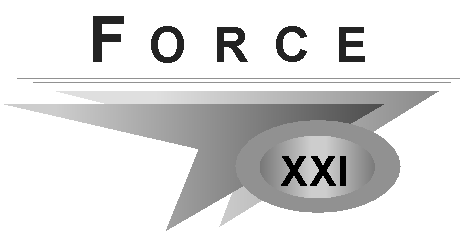 Watercraft Materiel Master Plan
Watercraft Materiel Master Plan Watercraft Materiel Master Plan
Watercraft Materiel Master Plan

Chapter One
I
NTRODUCTION1-1. PURPOSE. The November 1996 Army Watercraft Master Plan (AWMP) charts a course for the management and continuous modernization of the watercraft fleet through the year 2012. Army fiscal constraints heighten the need for a clear articulation of requirements, modernization strategies, resourcing, and fleet priorities. This chapter outlines the purpose, background, format, and responsibility for the publication of the AWMP.
A. Army watercraft provide the foundation for theater opening and reception of Army and joint forces committed in advancing the national military strategy and are an integral part of Force XXI for projecting and sustaining combat power. Waterborne logistics delivers 90 percent of all unit equipment and supplies of U.S. forces. Army watercraft — lighters and floating utility craft — provide the critical link between the offshore arrival of combat power loaded aboard strategic sealift ships and placing that power ashore in a ready to fight configuration. Army watercraft units are prepared to deploy at any time, to any location, to fulfill the objectives of this strategy. The AWMP provides the Army a means of managing the watercraft fleet with these objectives and missions in mind. Army watercraft project and sustain America’s forces.
B. The AWMP is the overarching document for the development and management of the Army watercraft fleet. It is based on federal, Department of Defense (DoD) directives and Department of the Army (DA) regulations for systems acquisition and management. The AWMP integrates a vision for the future by leveraging advanced and emerging technologies to provide greater operational flexibility and responsiveness for a Force XXI Army. Specifically, the AWMP:
1) Identifies a vision and strategy for the successful employment of a capable and responsive Army watercraft fleet.
2) Describes where we are by providing an assessment of current fleet capabilities.
3) Outlines where we’re going by quantifying Army watercraft requirements based on consideration of the Defense Planning Guidance (DPG), the Total Army Analysis (TAA) process, Commanders in Chief (CINCs)-driven operational requirements, and Army War Reserve (AWR) requirements. It also outlines materiel development, procurement, and modernization strategies required to maintain an operationally ready fleet.
4) Describes how we’ll get there in a resource constrained environment. The plan also identifies emerging concepts and technologies that enhance strategic sealift cargo delivery operations and identifies technology insertion opportunities in support of Force XXI initiatives.
5) Provides a comprehensive document that establishes common goals in shaping the Army watercraft fleet.
"The world’s best Army, trained and ready for victory. A total force of quality soldiers and civilians. A value based organization. An integral part of a joint team equipped with the most modern weapons and equipment our country can provide. Able to respond to our nation’s needs and changing to meet the challenges of today, tomorrow, and the 21st century."
Dennis J. Reimer, General, United States Army,
Chief of Staff, 28 July 1995
1-2. SCOPE.
A. General. The Army Strategic Mobility Program (ASMP) implements recommendations of the DoD Mobility Requirements Study (MRS). The ASMP enables the Army to respond quickly to crises around the world with combat forces that are versatile, expansible, sustainable, lethal, and readily deployable. As the Army continues to rightsize, it must maintain the capability to project Continental United States (CONUS) based and prepositioned forces and equipment to regional contingencies and contingency operations. The following objectives guided the formulation of the AWMP:
1) Determine the most effective mix of watercraft by unit and craft to ensure successful execution of the force projection and reception phases of an operation.
2) Identify research, development, acquisition, and maintenance needs to develop, procure, modernize, and maintain the Army’s fleet of watercraft.
3) Identify craft for divesture to reduce Army operation and maintenance (O&M) expenditures and to recapitalize the fleet with modern, productive craft.
B. Methodology for Developing Requirements. Formulation of the AWMP is based on a sound and supportable qualitative and quantitative methodology in support of the above stated objectives. Known or projected requirements were quantified based on TAA results, AWR requirements, and watercraft capabilities requirements studies. These requirements were compared against current capabilities inputting into a computer-based optimization model. Then excesses, shortages, and upgrades were identified by craft. Finally, strategies for divestiture, redistribution and modernization were developed.
C. Publication. The AWMP will be updated biennially to coincide with the TAA process under the direction of the Director of Combat Developments for Transportation.
1-3. FORMAT. The AWMP consists of seven chapters as summarized below:
A. Chapter 1. "Introduction" identifies the vision, purpose, background and scope of the AWMP. It also assigns responsibility for updates to the plan.
B. Chapter 2. "Army Watercraft Employment — Roles and Missions" defines the need for Army watercraft and describes the varied missions Army watercraft execute in support of the Army, other services, and the Regional Unified Commands. This chapter also identifies changes to the watercraft employment doctrine being recommended by supported forces or their representatives.
C. Chapter 3. "Building the Force" defines the TAA process, identifies TAA-03 approved Army watercraft structure by component and outlines the TAA-05 schedule. This chapter also identifies the types of units and their missions.
D. Chapter 4. "Prepositioning and Deployment of Army Watercraft" outlines the requirements for afloat prepositioning and forward stationing by unit set and quantifies throughput capabilities. This chapter also idenitifies the timeline and required watercraft unit sets necessary for follow-on deployment.
E. Chapter 5. "The Fleet Requirement" defines vessel missions, provides a craft assessment, outlines characteristics and capabilities, quantifies requirements and on-hand assets, delineates distribution by component, and articulates a modernization strategy for each type of craft.
F. Chapter 6. "Watercraft Modernization" identifies the overall strategy for modernization through maintenance, upgrades, research and development (R&D) and procurement. It also identifies emerging concepts and technologies that seek to reduce time, capital investment, and personnel needed to deliver combat and support forces ashore.
G. Chapter 7. "Training Army Mariners" outlines the scope of training required to ensure that Army mariners are adequately trained to safely and effectively operate the complex craft in the current Army fleet.
1-4. AWMAG. In 1994, the Combined Arms Support Command (CASCOM) formed an Army Watercraft Management Action Group (AWMAG) to provide a standing forum of key Army agencies to provide guidance for the management of the Army’s fleet of watercraft; define the vision for this force; and make recommendations regarding doctrine, force structure, prepositioning, and force modernization. A steering committee, chaired by the Transportation System Integrator DA Deputy Chief of Staff for Operations (DCSOPS), provides guidance to the full AWMAG. The AWMAG played an active role in developing the modernization strategy documented in this plan. The AWMAG meets a minimum of once a year to review program status, resolve issues, focus ideas, and shape the modernization plans contained in this plan. A copy of the AWMAG charter is provided in Appendix C.
1-5. SUMMARY. The AWMP reflects changing force structure, fiscal realities, and modernization priorities. Therefore, it will continue to evolve to reflect Army Doctrine and shape a fleet capable of supporting a force projection Army now and into the 21st century.

Army Watercraft Project and Sustain America’s Forces